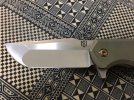Not the actual japanese weapon... As the grandson of a 5th degree kendoka it annoys me that Cold Steel et al use the term for a completely different concept.
Supposedly the american tanto has the advantage of a slicer that is also an extremely sturdy stabber.
I haven't yet put an american tanto through it's paces because I'm sold on the slicing ability of traditional curved shapes. I'm confident of what curves bring to the table.
I don't see the value of the subpoint: I imagine I'm familiar with what it can offer from using utility cutters with disposable blades. Am I missing something or does a subpoint do something they don't, other than being way thicker at the spine?
I also don't understand the need for more stabby sturdiness. Dagger points have been made to puncture ww2 steel helmets, clip points have been made to cut one's way through aluminum aircraft bodies. I myself have beaten the heck out of cheap drop points and spear points, including batoning and stabbing a 70s pickup door into pieces in a junkyard to get to a part inside. I've broken the tips off some knives, they were still usable and I had a lot more confidence in them once I reground them by hand into the shape they broke into. Therefore: cheap steel in a traditional shape seems stabby enough, or I can make the point stabby enough. My concern is the lock and the grip, which I have never found more suitable for stabbing than the tip of any folder I've owned.
I am not bashing tantos, except to say that american tantos are NOT traditional tantos, and the two quite different concepts deserve separate identities.
I am saying I feel confident of what I can do with traditionally curved blade shapes, and I'm asking what angular tantos can do better.
The one clear advantage I can see is in a blade long enough for a sword like slash or chop. If you're going to swing and just brush the tip of the blade against the work surface, I see a possible advantage of that angle and I see where a subpoint expands upon the usefulness of your tool. But. Realistically... Other than self defense, I cannot imagine needing *my edc* this way. I won't need my edc because I'll have a much larger heavier specialized tool. Which wouldn't have the sharply angled edge of an american tanto, because no designer that I know of deems that hard angle useful in other tools.
So for self defense? I have to ask, if the angled subpoint is superior, why didn't anyone realize that in the millenia when most warriors relied primarily on edged weapons?
If I'm going to carry a knife *for knife fighting* why is the tanto superior *for knife fighting* compared to all the other options that pop up if I google 'best self defense knife'?
Is it possibly that this is the best knife WTSHTF, if I had no other tool?
I'm ok considering that.... But my own conclusion is: EDC other tools, plus, have bugout bags nearby with my TEOTWAWKI gear. Not carry my TEOTWAWKI gear in my pocket at all times.
So that's my current thought.
Please, if you understand and like tantos, explain where I am mistaken or underinformed.












